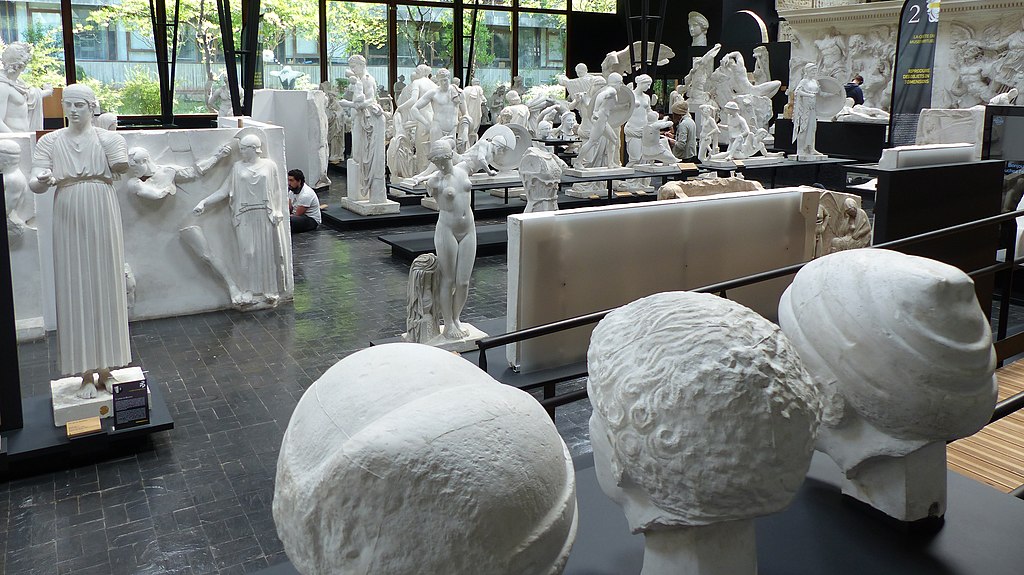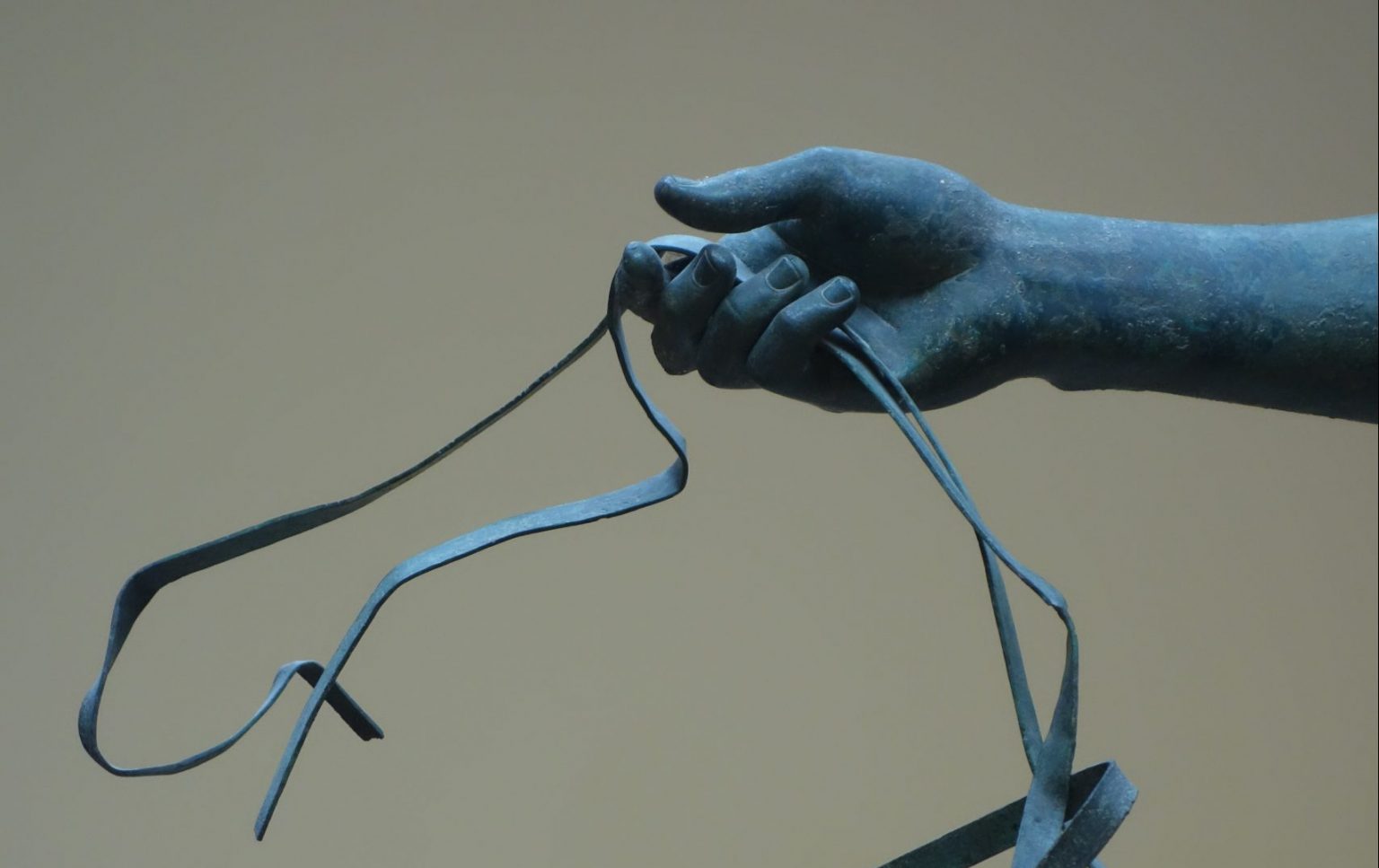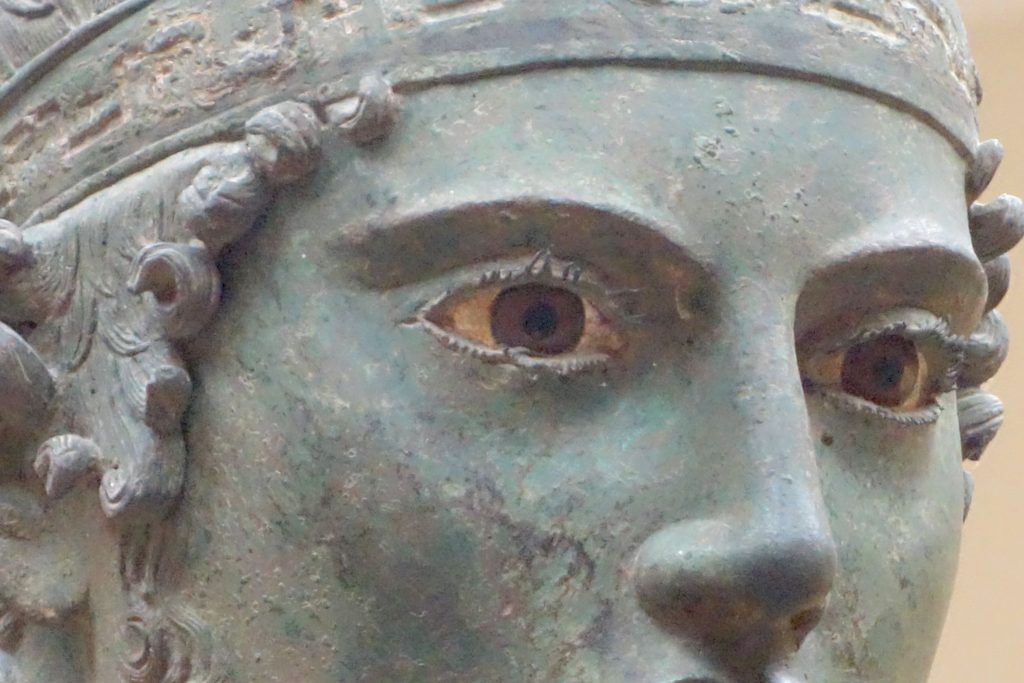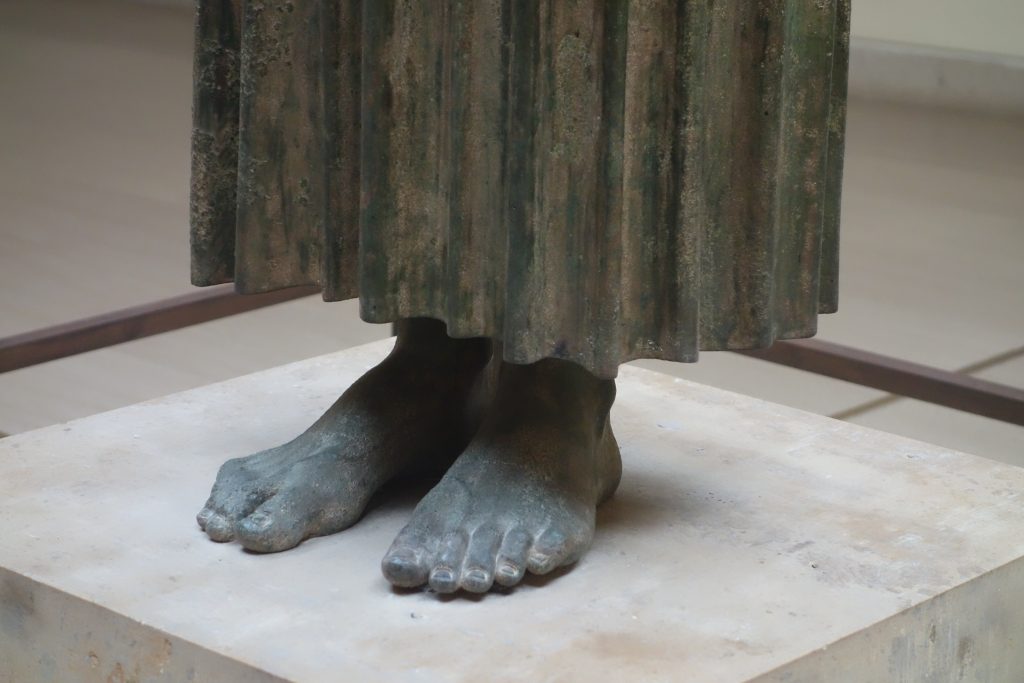Dear friends, I have a surprise for you—at least, for those of you, who aren’t long-time connoisseurs of classical art. Today, we’ll admire the piece that may radically change your idea of Greek sculpture.
Close your eyes for a second and imagine any ancient Greek statue. How does it look like? Snow-white marble, perfect forms, an air of noble detachment—such as the gods and athletes in the photograph from a little museum below, right?

Published under Creative Commons Attribution-Share Alike 4.0 without any changes; the source is Wikimedia Commons
These fine figures help us to gain some insight into Antique art, indeed. But they all are not the originals—they are ordinary plaster prints reproducing the shapes of the great masterpieces.
If you visit a bigger museum and find there the Greek hall with pure marble statues, most of them also will be copies created by Roman craftsmen. Very few true Greek sculptural works have survived.
One of the survivors is the piece called the Charioteer of Delphi (Heniokhos). You can see its plaster print in the left part of the photo—pay attention to the slender figure of a youth in a tunic.
Masterwork Buried under Rocks
Greeks regularly held Pythia games at Delphi. After the games, the best athletes and their families traditionally commissioned a statue to commemorate the victory. The statues were erected around the Sanctuary of Apollo as a tribute to the god.
In 1896, French excavators worked near the temple. The archaeologists discovered many empty pedestals and fragments of an impressive statuary complex. It initially included life-size horses, a quadriga, a groom, and a charioteer. The restorers managed to assemble only the figure of the racer.
The Charioteer probably owes its salvation to the earthquake that shakes the sanctuary in 373 B.C.: the statue was buried under a rock-fall. Its “neighbors”—including those which survived seismic catastrophe – were less lucky. They are considered to have been destroyed in the Middle Age… for metal. Like many other Early Greek sculptures, these athletes were made of bronze, not marble.
The Charioteer of Delphi: Сlose-Up
Heniokhos is now exhibited in the Delphi Archaeological Museum. Watch the short video to look at this rare example of ancient art from different angles:
When looking at the Charioteer of Delphi, you immediately notice the eyes. Their whites are inlaid with a special paste, their slightly reddish irises are semiprecious stone.
Sculpture with colored extras—it should be some sort of gaudy kitsch! However, our Charioteer doesn’t appear to be vulgar. Greek sculptors skillfully joined metals and gemstones.
Despite the fact that the face of the young man is strictly symmetrical, it does not show any rigidity. We believe the youth experiences complicated human emotions.
Photini N. Zaphiropoulou, the author of the album Classic Greek Masterpieces of Sculpture, writes about the Charioteer:
The athlete is not represented in the moment of action, but his pose and expression combine the concentrated effort and focused attention demanded during the race with pride at the anticipated victory. The artist has sculpted the body with volume and depth, presenting it as a living organism, with its internal design, the torsion of the upper body in relation to the lower conveys not immobility but the momentary, and therefore motion.
The bronze charioteer hardly resembles the man who won the race and dedicated the statue to Apollo. Greeks didn’t attempt to reproduce the features of particular individuals in their sculptures. The task of the true master was to create an ideal human figure and breathe life into it.
The Charioteer is humanized by means of little details—delicate eyelashes, soft side-curls. The racer’s thin fingers hold the reins so freely that they seem to be moving.
The bare feet are incredibly naturalistic as well— veins are clearly distinguishable on them. The tunic emphasizes the youth’s solid posture. Thanks to its folds, the figure is similar to an elegant Ionic column.
In encyclopedias, the pictures of the Charioteer are usually published together with the photos of two stylistically related figures—the statues recovered from the sea near Italian comune Riace in 1972. The Riace sculptures depict either athletes or warriors. Also made of bronze, they have inlaid eyes, nipples, and lips. The “youngest” warrior has even teeth.
Of course, marble sculptures existed in Ancient Greece (famous Phidias, for example, preferred marble to bronze), yet they usually weren’t completely white. Greeks painted the surface of their sculptural works.
The people whose culture influenced the course of development of the entire European civilization loved richly contrasting vivid colors. I think this says a lot about them.
- Classic Greek Masterpieces of Sculpture – Photini N. Zaphiropoulou, Abrams, New York
- История искусства [History of Art] – Эрнст Гомбрих, Москва, 2019
- The Art Book – DK, Penguin Random House, 2017





Yeah, everything we know (fron history books) about history and statues is FAKE, we knowm but NIRT in the sens you try to guess here. Sory, but itls laughable, everything you said here. Not only because of the verified (not in all cases, but most) dating of many ancient statues, from Pelasgia, (which you wrongly call here “Greece” :D)), but the bronze age is PRE-greek! Not after-greek. This is a Pelasgian statue! Not a “greek” statue. .The invading Sea Peoples (greeks and semites) in the second millenium BC, masacred everything in site, and then put an end to the bronze age. This statue IS NOT from the 5-th century BC, not it shows “a greek”. Even it’s body line allover (soft, exactly like of the Pharaoh of Egypt, long before the greeks) proves that. You even place this dating (through that infantile and funny youtube clip you attached here) within the Greek DARK Ages, where no way no how existed ANY “greek” ceramics (at that point NOT existing ANY “greek” culture, of ANY kind! Only Sea Peoples canibals!), let alone masterpieces of bronze like this one. Anyway, the whole World history is allready debunked, an posted in tens of episodes allready (if you never heard of that seri, you are clearly from another planet), full of proof of any kind, about the true history of the world, where it is also proven that the descendents of the ancient Sea Peoples are the ones everybody mention today, like Klaus Schwab, Bill Gates and the rest. And even the eyes of this sculpture (style and materials) is 100% Pelasgian style (the same as Dacians and Thracians), identical to those of Seuthes III of Thrace and other Hyperborean (Pelasgian, Dacian etc, many names, one race/nation) masterpieces.
Have a nice day.
Thank you for your comment! Of course, both I and the authors of the books I used to find the information about the Charioteer of Delphi, could have made some mistakes. I will be very grateful if you can recommend me more reliable sources of information.
Loraine, can you please provide some bibliography for your assertions? Clearly, when someone knows as much as you do, there must be some peer-reviewed scholarly work out there to support your claims, right?